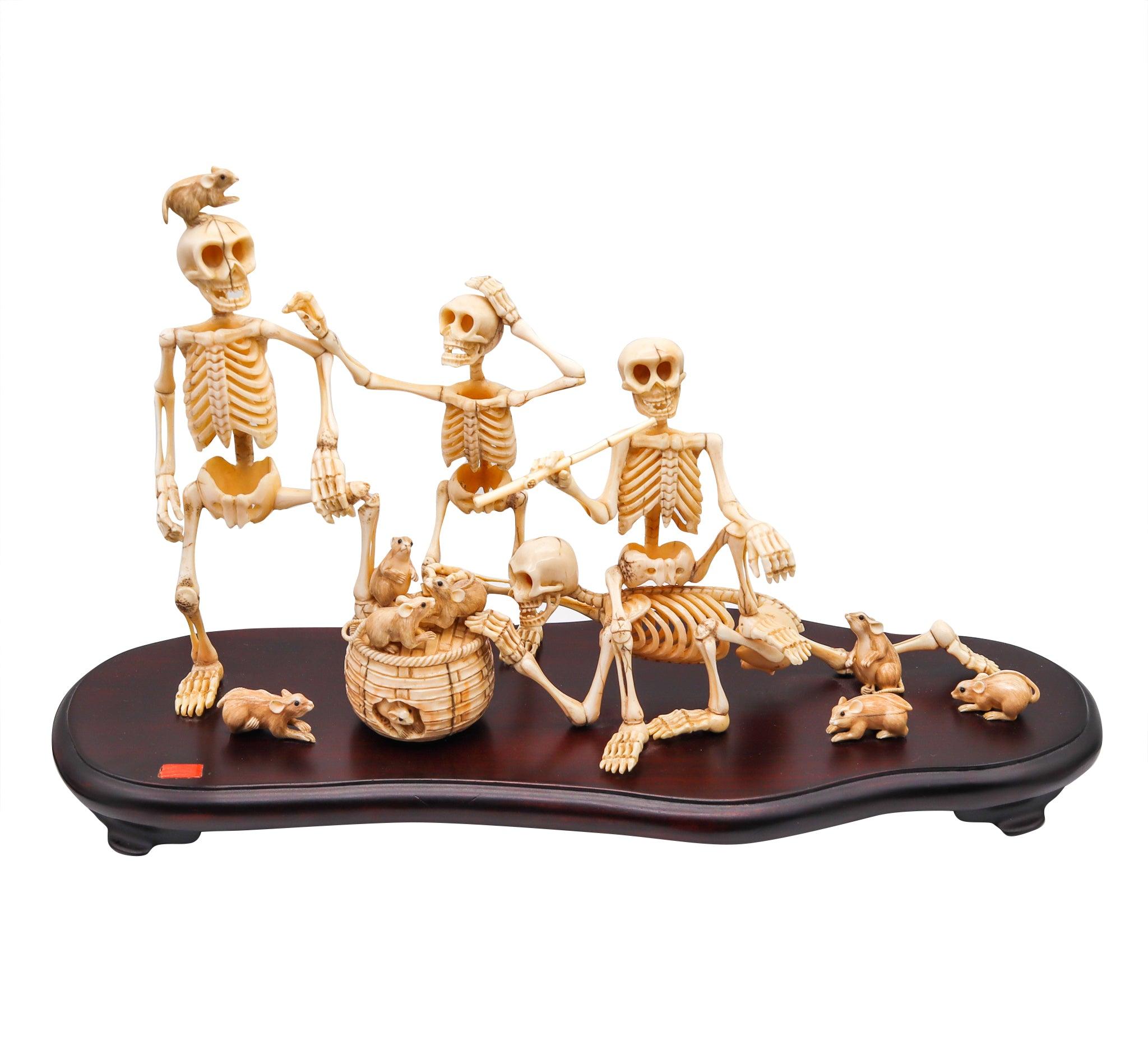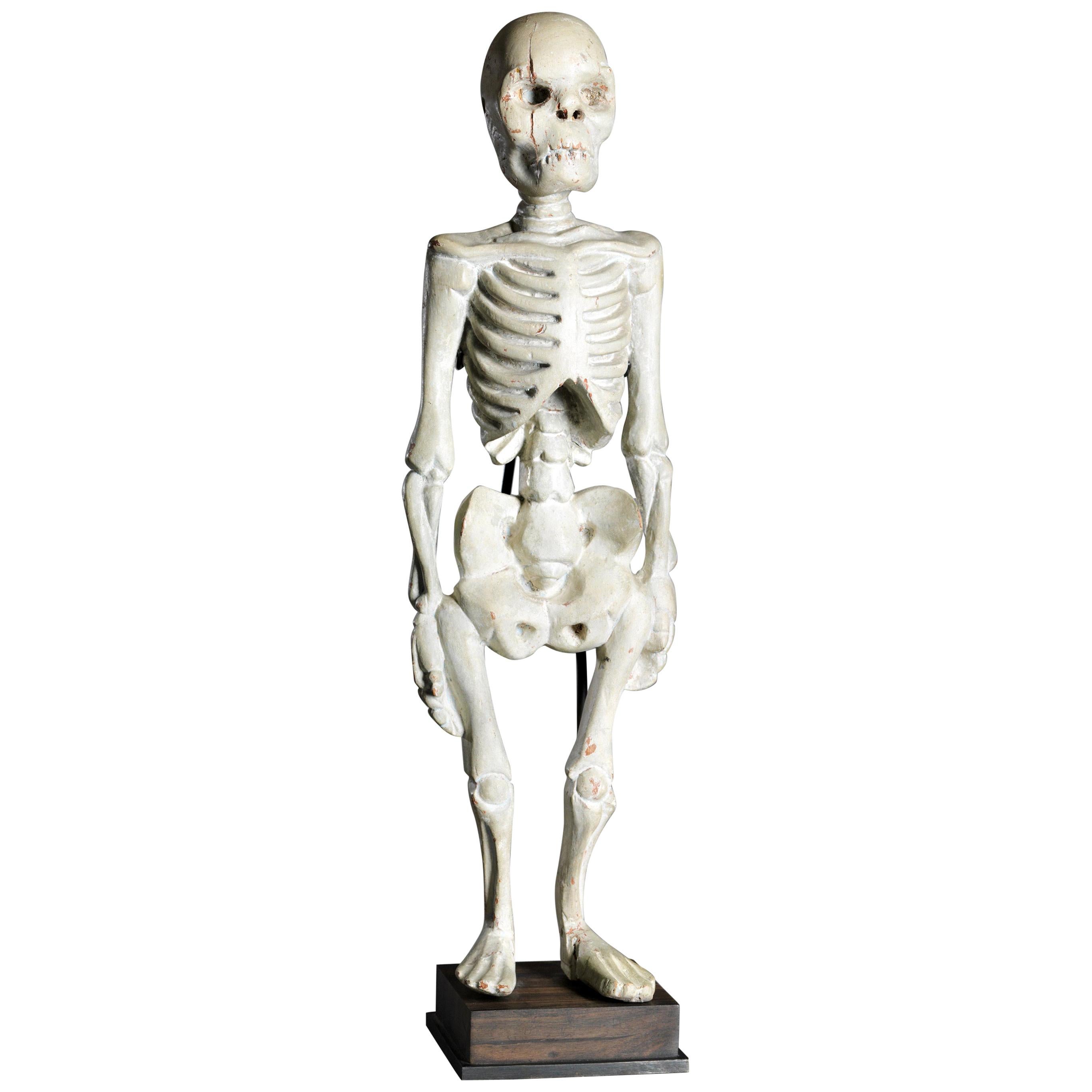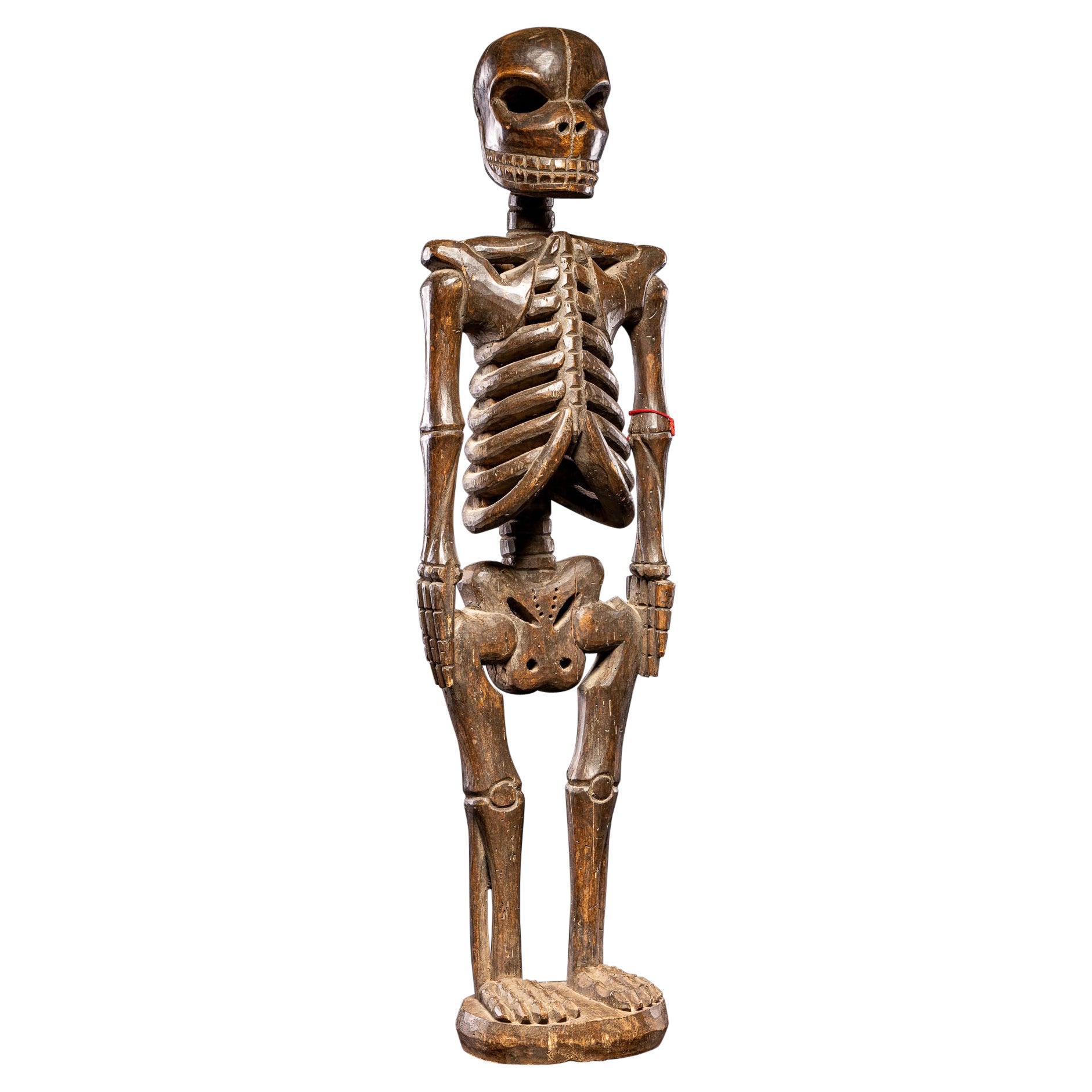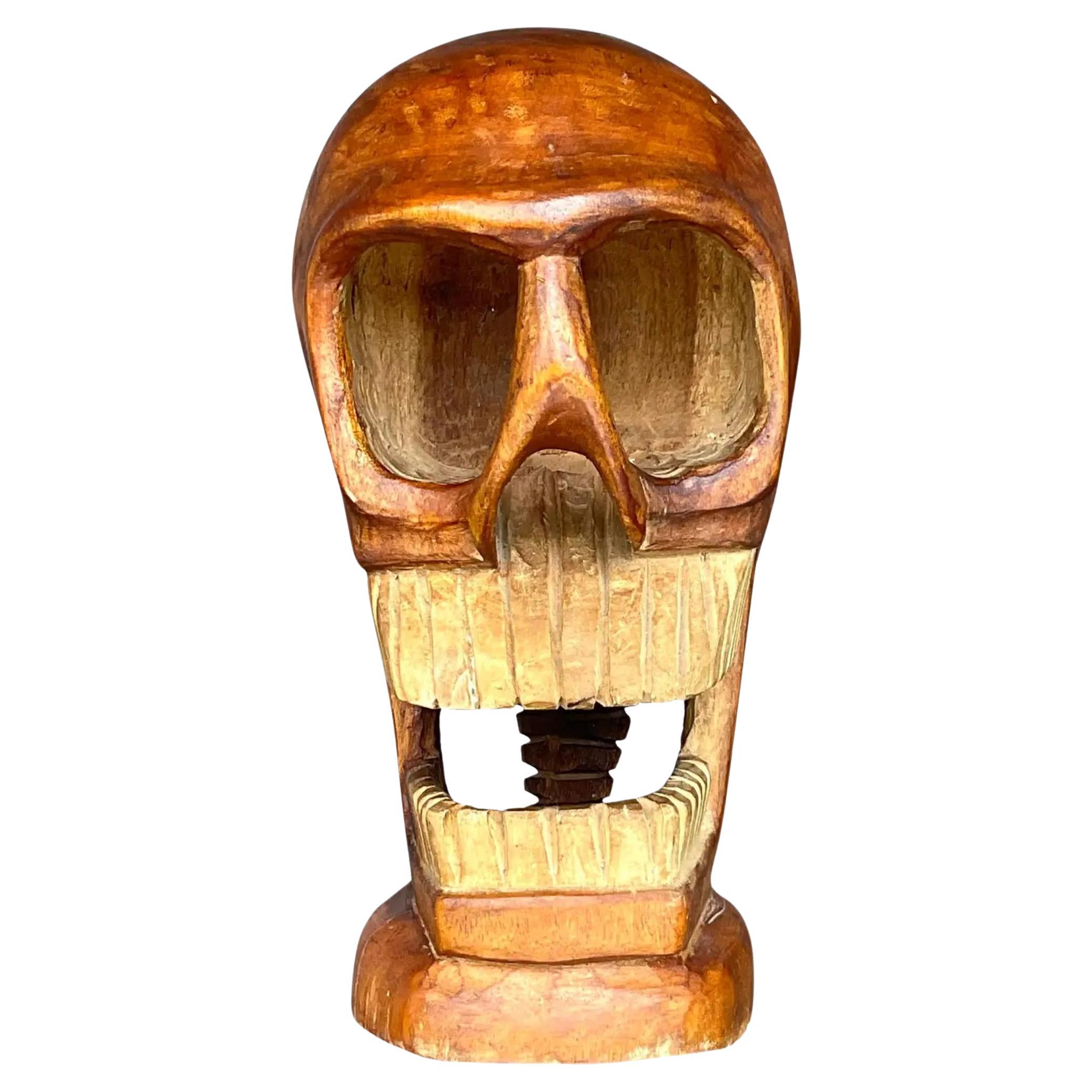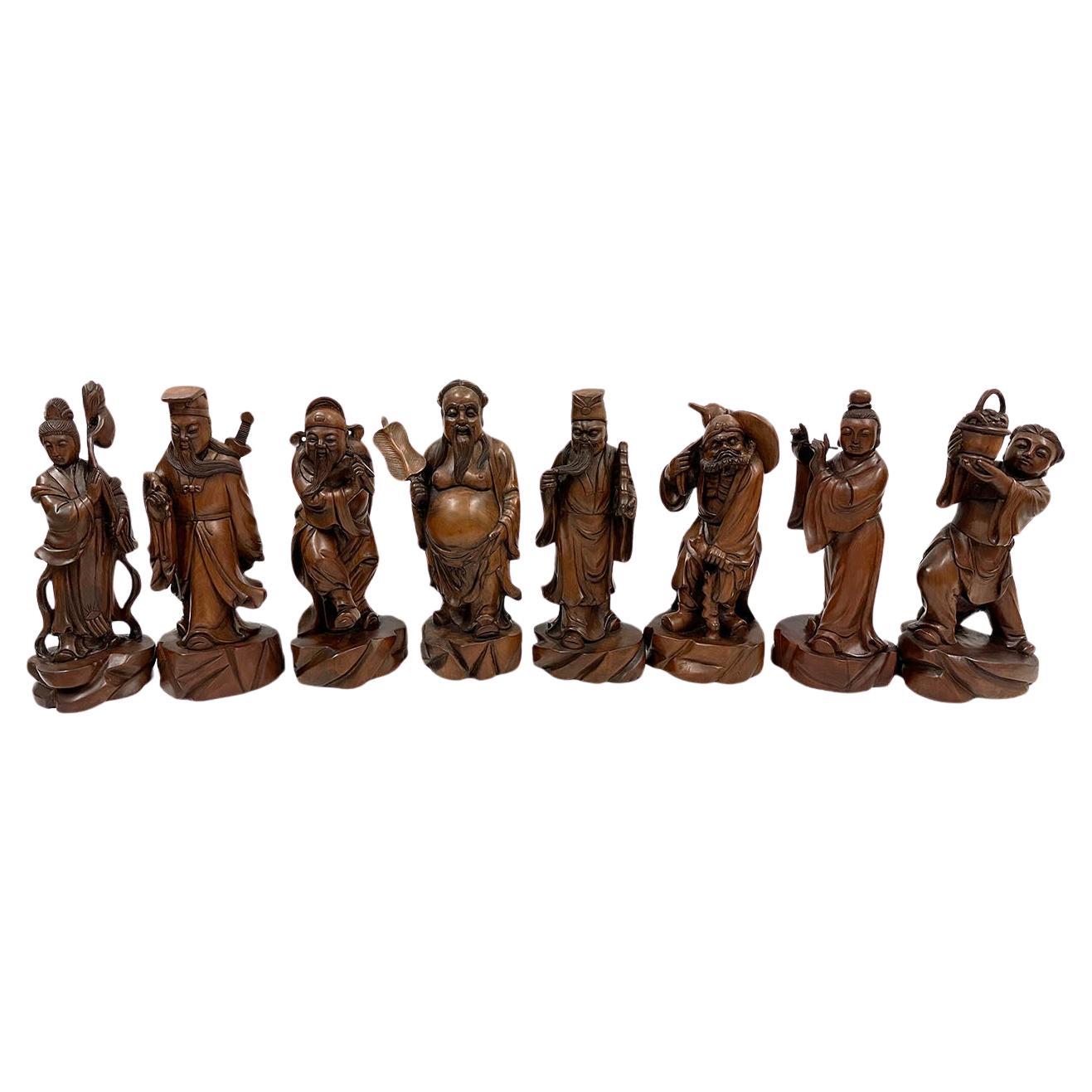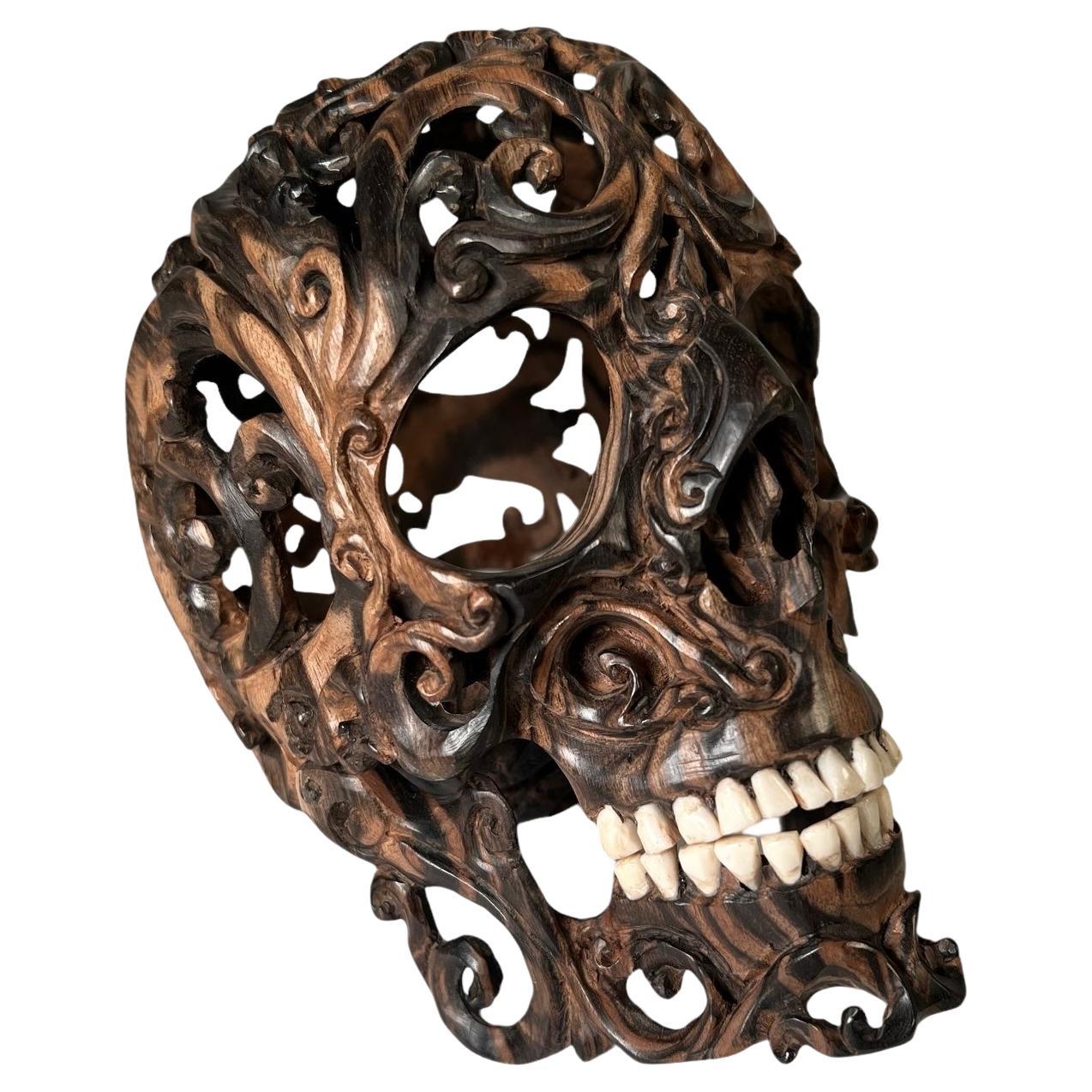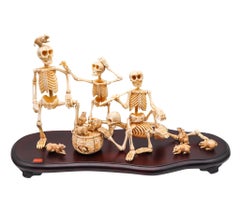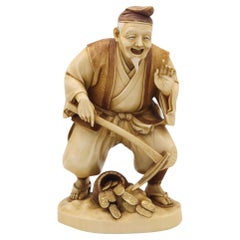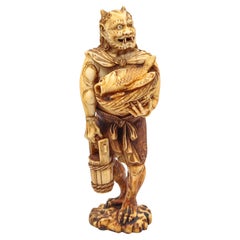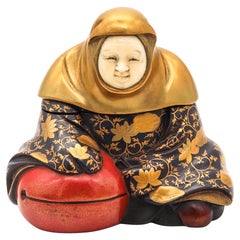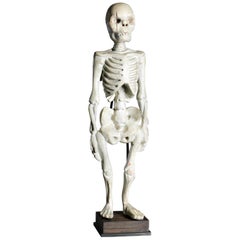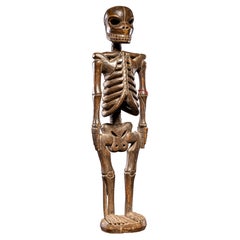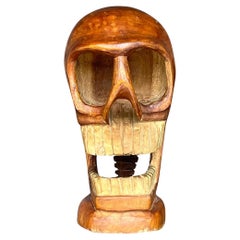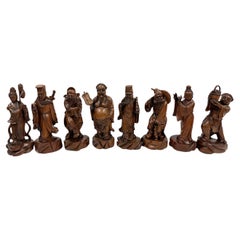Artículos similares a JAPÓN 1890 Periodo Meiji Escultura Okimono De Un Grupo De Esqueletos Fumando
¿Quieres más imágenes o vídeos?
Solicita imágenes o vídeos adicionales al vendedor
1 de 12
JAPÓN 1890 Periodo Meiji Escultura Okimono De Un Grupo De Esqueletos Fumando
13.202,36 €
17.603,15 €Descuento del 25 %
Acerca del artículo
Okimono escultórico firmado del periodo japonés Meiji (1868-1912).
Ensamblaje escultórico muy raro, inusual y de gran tamaño de una pieza de okimono displaying. Creada en Japón durante el periodo imperial Meiji (1868-1912). Este extraordinario okimono fue cuidadosamente tallado y representa a un grupo de tres esqueletos juguetones (Gaikotsu) representados de forma intrincada y realista, en posición relajada y de descanso, bebiendo y fumando. Dos de ellos, probablemente representaciones masculinas, descansan en un sofá de mimbre. La tercera, es una mujer sentada en un taburete inferior que ofrece copas de sake en una bandeja redonda. En la escena hay un pequeño banco rectangular.
La composición se expone sobre una plataforma de madera tallada de cuatro patas con una placa roja incrustada grabada con la firma del artista. El nivel de detalle y la calidad de la talla son realmente excepcionales.
Tiene unas medidas exactas de 209,55 mm por 196,85 mm por 127,76 mm (8,25 x 7,75 x 5,03 Pulgadas).
Tras una extensa recopilación de datos, comparables y referencias a esta pieza, sólo hemos podido encontrar tres esculturas okimono como ésta con temas similares y la misma calidad de trabajo.
Referencias Nota: Una talla similar de cuatro esqueletos jugando una animada partida de dominó, firmada Shutaro en una placa roja rectangular incrustada, fue vendida en Londres por Christie's South Kensington el 14 de octubre de 2014, Lote 120 Venta 5546.
Referencias Nota: Una talla similar con cuatro esqueletos en una escena victoriana por lo demás típica de un fotógrafo y tres modelos firmada Shutaro en una placa roja rectangular incrustada, se vendió en Edimburgo en Lyon & Turnbull el 7 de noviembre de 2018.
Referencias Nota: Una talla similar con cinco esqueletos sentados, jugando a las cartas y bebiendo, fue vendida en Londres por John Nicholson Fine Art el 26 de septiembre de 2018.
Periodo Meiji
Se trata de una era de la historia de Japón que se extendió desde el 23 de octubre de 1868 hasta el 30 de julio de 1912.La era Meiji fue la primera mitad del Imperio de Japón, cuando el pueblo japonés pasó de ser una sociedad feudal aislada en peligro de colonización por las potencias occidentales al nuevo paradigma de un Estado-nación moderno e industrializado y una gran potencia emergente, influida por las ideas científicas, tecnológicas, filosóficas, políticas, jurídicas y estéticas occidentales. Como resultado de esa adopción masiva de ideas radicalmente diferentes, los cambios en Japón fueron profundos y afectaron a su estructura social, su política interna, su economía, su ejército y sus relaciones exteriores. El periodo correspondió al reinado del emperador Meiji. Fue precedida por la era Keiō y fue sucedida por la era Taishō, al acceder el emperador Taishō.
Okimono
Es un término japonés que significa para exhibir un ornamento, objeto de arte u objeto decorativo, normalmente expuesto en un tokonoma o butsudan "altar budista". Es un adorno o figura, especialmente uno colocado en una habitación de invitados. Un okimono puede ser una pequeña talla japonesa, similar pero mayor que un netsuke. A diferencia del netsuke, que tenía una finalidad específica, el okimono es exclusivamente decorativo y se exponía en el tokonoma. Durante el periodo Meiji, se fabricaron muchos okimonos para exportarlos a Occidente.
Gaikotsu, que significa esqueleto, aparece a menudo en los antiguos mitos japoneses y en los dibujos de los Youkai. Los esqueletos con sólo huesos humanos se llaman "sharekoube". Otros Youkai famosos basados en esqueletos son Gasha Dokuro, Honeonna y Kyoukotsu.
Nota importante: En lo que respecta al caparazón de tortuga antiguo o al marfil, somos grandes partidarios de la protección de las especies en peligro de extinción en nuestro mundo moderno. Nunca compramos ni vendemos nada que tenga 100 años o más, no cazamos, sabiendo que esas medidas también protegen a los animales salvajes de hoy. También reconocemos la vasta historia cultural que preservamos con nuestro cuidado y reverencia hacia estos objetos antiguos, y estamos de acuerdo con las citas que afirman que los objetos de más de 100 años no tienen nada que ver con el agotamiento de las especies en nuestro mundo actual.
Estado: El estado general de esta pieza es excepcional, sin que le falte ninguna pieza ni esté rota, ni siquiera presenta restauración alguna. Esta pieza ha sido cuidadosamente inspeccionada para garantizar su estado y autenticidad.
REF. INVENTARIO D012625ACEM/.8934
- Dimensiones:Altura: 19,69 cm (7,75 in)Anchura: 20,96 cm (8,25 in)Profundidad: 12,83 cm (5,05 in)
- Estilo:Meiji (Del período)
- Materiales y técnicas:
- Lugar de origen:
- Época:
- Fecha de fabricación:1890
- Estado:Desgaste acorde con la edad y el uso. El estado general de esta pieza es excepcional, sin que le falten piezas ni estén rotas, ni siquiera muestra restauración alguna. Esta pieza ha sido cuidadosamente inspeccionada para garantizar su estado y autenticidad.
- Ubicación del vendedor:Miami, FL
- Número de referencia:Vendedor: D012625ACEM/.89341stDibs: LU8303243370192
Sobre el vendedor
5,0
Vendedor Oro
Vendedores premium que mantienen una calificación de +4,3 y tiempos de respuesta de 24 horas
Vendedor de 1stDibs desde 2023
209 ventas en 1stDibs
Tiempo de respuesta usual: 3 horas
- EnvíoRecuperando presupuesto…Envío desde: Miami, FL
- Política de devolución
Partes de esta página se han traducido automáticamente. 1stDibs no puede garantizar la exactitud de las traducciones. El inglés es el idioma predeterminado de este sitio web.
Garantía de autenticidad
En el improbable caso de que haya algún problema con la autenticidad de un artículo, ponte en contacto con nosotros en un plazo de 1 año para recibir un reembolso total. DetallesGarantía de devolución de dinero
Si tu artículo no es como se describe, sufre daños durante el transporte o no llega, ponte en contacto con nosotros en un plazo de 7 días para recibir un reembolso total. DetallesCancelación dentro de las 24 horas
Tienes un período de gracia de 24 horas para reconsiderar tu compra, sin preguntas.Vendedores profesionales aprobados
Nuestros vendedores de primera clase deben cumplir estrictos estándares de servicio para mantener la integridad de nuestros anuncios.Garantía de igualación de precios
Si encuentras que un vendedor publicó el mismo artículo por un precio menor en otro lado, igualaremos ese precio.Entrega global de confianza
Nuestra red de transporte de primera ofrece opciones de envío especializado en todo el mundo, que incluye envío personalizado.Más de este vendedor
Ver todoJAPÓN 1890 Periodo Meiji Escultura Okimono Con Un Grupo De Esqueletos Jugando
Un Okimono firmado del periodo japonés Meiji (1868-1912).
Ensamblaje escultórico muy raro, inusual y de gran tamaño de una pieza de okimono displaying. Creada en Japón durante el pe...
Categoría
Antiguo, Década de 1890, Japonés, Meiji, Esculturas y tallas
Materiales
Madera, Laca
13.202 € Precio de venta
Descuento del 25 %
JAPÓN 1890 Meiji Figura tallada del Dios de la Fortuna Daikoku como granjero con monedas
Una escultura tallada japonesa de Daikoku.
Magnífica escultura del dios de la fortuna Daikoku CON MÁS DE 100 AÑOS DE ANTIGÜEDAD, creada en Japón durante el periodo Meiji, hacia 1890...
Categoría
Antiguo, Década de 1890, Japonés, Meiji, Esculturas y tallas
Materiales
Oro
3293 € Precio de venta
Descuento del 25 %
JAPÓN 1880 Meiji Firmado Escultura Okimono De ONI Demonio Sosteniendo Cesta Con Peces
Escultura okimono de Oni del periodo Meiji.
Se trata de una excepcional escultura okimono creada a finales del siglo XIX, durante el Japón imperial de la era Meiji, allá por 1880. L...
Categoría
Antiguo, Década de 1880, Japonés, Meiji, Esculturas y tallas
Materiales
Vidrio
1816 € Precio de venta
Descuento del 25 %
KAZUYOSHI Japón Meiji 1890 Caja En Madera Lacada Y Dorada Mujer Sentada Drapeada
Caja Meiji lacada con forma de dama sentada, obra de Meigetsusai Kazuyoshi.
Se trata de una caja decorativa extremadamente rara hecha con la forma de una sentada completamente vesti...
Categoría
Antiguo, Década de 1890, Japonés, Meiji, Esculturas y tallas
Materiales
Hoja de oro
3293 € Precio de venta
Descuento del 25 %
JAPÓN Periodo Edo 1825 Escultura de Buda sentado en madera maciza tallada y dorada
Escultura de Buda sentado en madera tallada y dorada del Periodo Edo.
Se trata de una figura de madera tallada de un Buda sentado, magníficamente refinada, con un fabuloso dorado en...
Categoría
Antiguo, Década de 1820, Japonés, Edo, Esculturas y tallas
Materiales
Oro
2312 € Precio de venta
Descuento del 25 %
CHINA REPUBLICANA Siglo XX Estatua de Buda En Porcelana Marca Zeng Long Sheng
Un Buda sentado de porcelana de la República de China.
Se trata de una hermosa figura devota antigua de un Buda feliz sentado, creada en la República de China a principios del siglo...
Categoría
Vintage, Década de 1920, Chino, Exportación china, Esculturas y tallas
Materiales
Esmalte
659 € Precio de venta
Descuento del 25 %
También te puede gustar
Etnodiseño Escultura de Esqueleto Humano de Pie en Madera, Sudeste Asiático
La escultura data de principios del siglo XX y presenta una maravillosa pátina.
Categoría
principios del siglo XX, Birmano, Esculturas figurativas
Materiales
Madera
Esqueleto ceremonial de madera dura de una sola pieza, Nigeria.
Una forma poco común, la figura abstracta con boca llena de dientes que se mantiene erguida sobre una base integral.
Categoría
siglo XX, Nigeriano, Esculturas figurativas
Materiales
Madera dura
Escultura vintage boho de calavera de madera tallada
Una fantástica calavera tallada de estilo boho vintage. Una composición abstracta con bellos detalles de vetas de madera. Adquirida a una finca de Palm Beach.
Categoría
finales del siglo XX, Estadounidense, Bohemio, Esculturas figurativas
Materiales
Madera
Estatuas de Ocho Inmortales talladas en madera del siglo XX
Los Ocho Inmortales son los ocho inmortales del taoísmo, que representan a ocho grupos diferentes de personas, hombres, mujeres, viejos y jóvenes, pobres, humildes, ricos y nobles.
P...
Categoría
mediados del siglo XX, Chino, Exportación china, Esculturas figurativas
Materiales
Boj
1948 € Precio de venta juego
Descuento del 25 %
Escultura de calavera de madera tallada
Escultura asiática de cráneo tallada en madera con dientes auténticos y mandíbula móvil. Finales del siglo XX.
Categoría
Vintage, Década de 1970, Indonesio, Esculturas abstractas
Materiales
Madera
Escultura esqueleto monumental de arte popular, años 50 EE.UU.
Una emocionante escultura hecha con piezas cortadas y pintadas de hierro encontrado. Esotérica, caprichosa y encantadora: esta pieza tiene una presencia increíble. Con más de 2 metro...
Categoría
Vintage, Década de 1950, Estadounidense, Esculturas figurativas
Materiales
Hierro
